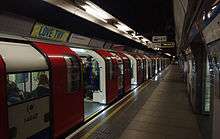Blackhorse Road station
| Blackhorse Road | |
|---|---|
 | |
 Blackhorse Road Location of Blackhorse Road in Greater London | |
| Location | Walthamstow |
| Local authority | London Borough of Waltham Forest |
| Managed by | London Underground |
| Owner |
London Underground Network Rail |
| Station code | BHO |
| DfT category | E |
| Number of platforms | 4 |
| Fare zone | 3 |
| London Underground annual entry and exit | |
| 2012 |
|
| 2013 |
|
| 2014 |
|
| 2015 |
|
| National Rail annual entry and exit | |
| 2010–11 |
|
| 2011–12 |
|
| 2012–13 |
|
| 2013–14 |
|
| 2014–15 |
|
| Key dates | |
| 1894 | National Rail opened |
| 1968 | Victoria line started |
| 1981 | BR station resited |
| Other information | |
| Lists of stations | |
| External links | |
| WGS84 | 51°35′13″N 0°02′29″W / 51.586944°N 0.041389°WCoordinates: 51°35′13″N 0°02′29″W / 51.586944°N 0.041389°W |
|
| |
Blackhorse Road is a London Overground and London Underground station located at the junction of Blackhorse Road/Blackhorse Lane with Forest Road in the Walthamstow neighbourhood of the London Borough of Waltham Forest, London, England. The station is on the Victoria line of the London Underground and is the penultimate station on the eastern end of that line. Above ground, the station is located approximately at the midpoint of the Gospel Oak to Barking Line (GOBLIN) of the London Overground.
The station is in Travelcard Zone 3[3] and is the least used station on the Victoria line with 6.44 million passengers per year.
Ticket barriers control access to all platforms. Passengers using Oyster cards are required to tap on an interchange Oyster card reader when transferring between the two lines.
History
The station was opened on 9 July 1894[4] by the Tottenham and Forest Gate Railway and was originally situated east of Blackhorse Road. The station was resited by British Rail on 14 December 1981[5] to provide better interchange with the tube station which had opened on 1 September 1968.
The station today
Structure
The station contains two underground platforms for the Victoria line and two for the London Overground. Due to budget restraints at the time of construction, the underground station, like many stations on the Victoria line, was never completely finished to the standard of other lines. White ceiling panels were never fixed to the ceilings above the platforms; instead the steel tunnel segments were painted black and used to support the fixtures and fittings. This has had a detrimental effect on the lighting levels.
Artwork

There are two distinct works of art at the station, both depicting black horses, in reference to the station's name. One is in the form of a tile motif depicting a black horse on a white cameo against a light blue background, identical to the Victoria line's colour. It was done by Hans Unger, who also did the tile motif at Seven Sisters tube station. The other is a mural of a black horse outside the station's entrance, by David McFall.[6]
Services

During peak periods, trains run approximately every two minutes on the Victoria line (up to 33 trains per hour) in both directions.[7][8]
The typical off-peak service for London Overground (Mondays-Fridays & Sundays) in trains per hour (tph) is:
The typical off-peak service for London Overground (Saturdays) in trains per hour (tph) is:
From June 2016 until February 2017, services on the route are suspended whilst it is electrified - this project involves lowering track in several places, rebuilding bridges and lengthening platforms as well as installing overhead wires.[10] A replacement bus service is in operation for the duration of the closure period.
Connections
London Bus routes 123, 158, 230 and night route N73 serve the station.[11]
References
- 1 2 3 4 "Multi-year station entry-and-exit figures" (XLS). London Underground station passenger usage data. Transport for London. April 2016. Retrieved 3 May 2016.
- 1 2 3 4 5 "Station usage estimates". Rail statistics. Office of Rail Regulation. Please note: Some methodology may vary year on year.
- ↑ Transport for London (January 2016). Standard Tube Map (PDF) (Map). Not to scale. Transport for London. Archived (PDF) from the original on 3 January 2015.
- ↑ The Forgotten Stations of Greater London by J.E.Connor and B.Halford
- ↑ The Forgotten Stations of Greater London by J.Connor and B.Halford ISBN 0 947699 17 1
- ↑ Porter, Laura. "Blackhorse Road". GoLondon. Retrieved 4 August 2014.
- ↑ "Victoria line timetable: From Blackhorse Road Underground Station to Walthamstow Central Underground Station". Transport for London. Retrieved 13 March 2015.
- ↑ "Victoria line timetable: From Blackhorse Road Underground Station to Tottenham Hale Underground Station". Transport for London. Retrieved 13 March 2015.
- 1 2 3 4 London Overground Gospel Oak to Barking timetable
- ↑ "Eight-month closure planned for GOBLIN electrification"Global Rail News article 2 February 2016; Retrieved 7 June 2016
- ↑ "Buses from Blackhorse Road" (PDF). 20 October 2013. Retrieved 13 March 2015.
External links
| Wikimedia Commons has media related to Blackhorse Road station. |
- Train times and station information for Blackhorse Road station from National Rail
| Preceding station | Following station | |||
|---|---|---|---|---|
towards Brixton | Victoria line | Terminus |
||
| Preceding station | Following station | |||
towards Gospel Oak | Gospel Oak to Barking Line | towards Barking |